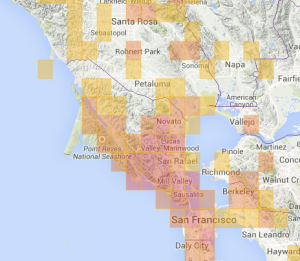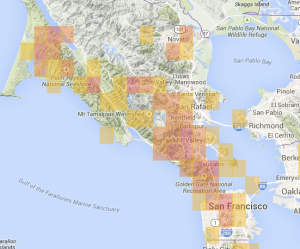In addition to the fire danger, French and Scotch broom pose challenges to the Marin’s native flora and fauna. Both plants are considered aggressive, nonnative invasive species that displace native plant species, threaten reforestation efforts, and can dominate ecosystems.
French Broom
French broom is the most prevalent of the brooms (French, Scotch, Portuguese, and Spanish) in Marin County and California; it occupies approximately 100,000 acres in the state. Its resilience and rapid reproduction and growth rates make it an aggressive invasive species.
French broom is a remarkably durable plant, which makes it especially difficult to eradicate. It can resprout after it has been cut, frozen, and sometimes burned. Therefore, cutting, freezing, and burning the broom are ineffective methods for removal. As Jerry Riessen, president of the Tiburon Open Space Committee, said, “Cutting it…all that does it make it mad. Goats just make it mad. The only thing that really works is pulling it and chemicals.” To successfully eliminate the broom, one must pull out or severely damage the roots of the plant.
French broom also fixes, or holds, atmospheric nitrogen, which changes the soil composition and gives advantages to other non-native species that require high levels of nitrogen in the soil.
A medium-sized French broom shrub can produce over 8,000 seeds each year, many of which can lie dormant for years before sprouting. Furthermore, French broom has a higher growth rate than other broom species. In the first few years, broom can grow between nine and twelve feet. The young shrubs quickly grow big enough to shade tree seedlings, making it difficult for the trees to grow. French broom foliage and seeds contain quinolizidine alkaloid, which is toxic to many native and nonnative animal species that live in Marin. It can cause staggering followed by paralysis in livestock.
Scotch Broom
Although Scotch broom is less prevalent in California, it covers about 70,000 acres in the state. Scotch broom causes many of the same problems as French broom. Like French broom, it quickly forms monospecific clusters, where it crowds out the native species and makes it impossible for anything else to grow. The seeds are toxic to ungulates (mammals with hooves) and cause digestive disorders in horses. Its mature plants are inedible and cannot used for forage.
Because both French and Scotch broom displace native species and change soil conditions, they degrade Marin’s natural habitats and threaten its native wildlife.
Sources:
“Broom: An Invasive Plant.” Parks.ca.gov. California State Parks, 1 Jan. 2009. Web. 19 Apr. 2015. <http://www.parks.ca.gov/pages/23071/files/broom insert.pdf>.
“Invasive Plants of California’s Wildland: Cytisus scoparius.” Cal-ipc.org. California Invasive Plant Council. Web. 18 Apr. 2015. <http://www.cal-ipc.org/ip/management/ipcw/pages/detailreport.cfm@usernumber=39&surveynumber=182.php
“Invasive Plants of California’s Wildland: Genista Monspessulana.” Cal-ipc.org. California Invasive Plant Council. Web. 18 Apr. 2015. <http://www.cal-ipc.org/ip/management/ipcw/pages/detailreport.cfm@usernumber=52&surveynumber=182.php
Leblanc, John W. “Getting a Handle on Broom.” Anrcatalog.ucdavis.edu. University of California, Davis. Web. 19 Apr. 2015. <http://anrcatalog.ucdavis.edu/pdf/8049.pdf>.
Oneto, S.R., J.M. DiTomaso, and G.B. Kyser. “How to Manage Pests: Brooms.” Brooms Management Guidelines–UC IPM. University of California, Davis. Web. 19 Apr. 2015. <http://www.ipm.ucdavis.edu/PMG/PESTNOTES/pn74147.html>.

